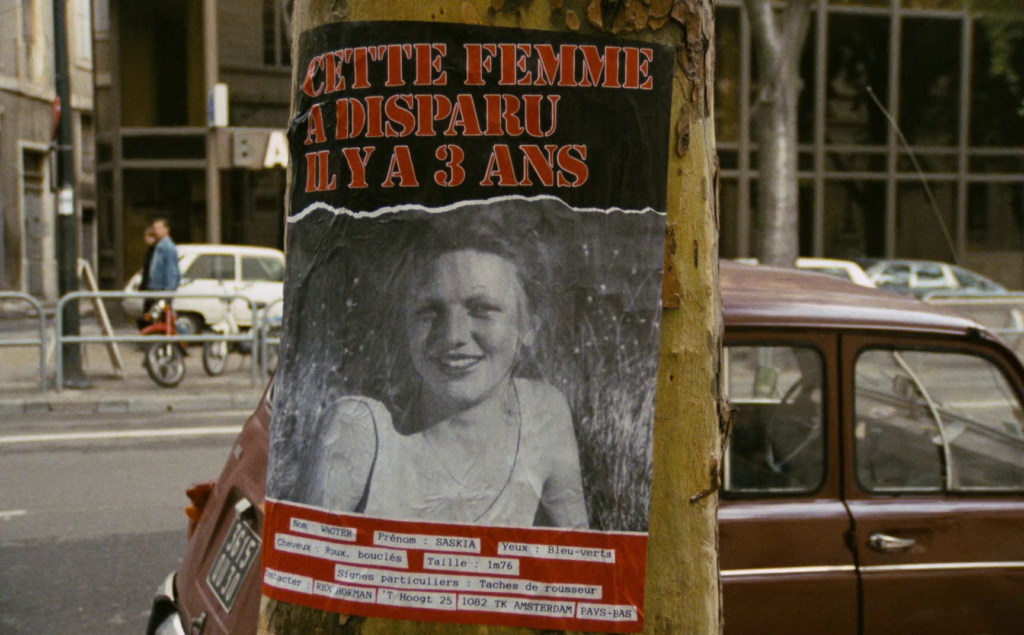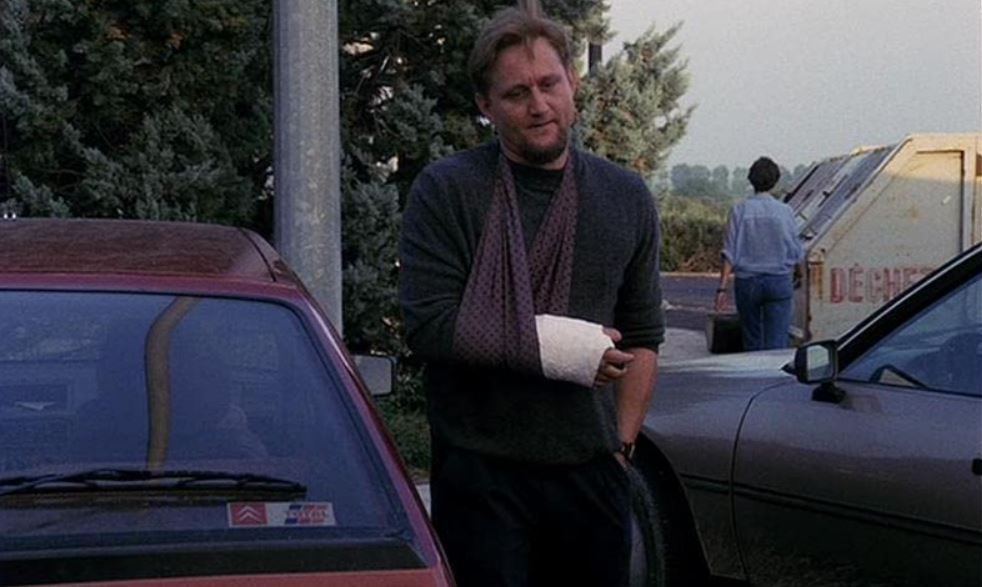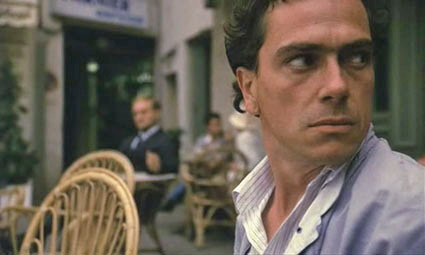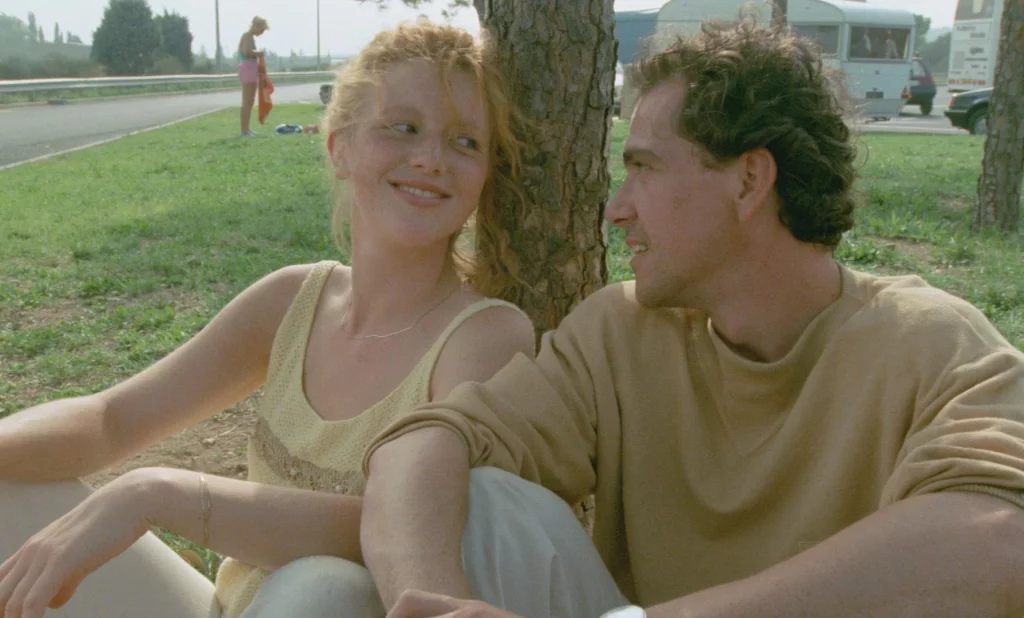|MH Rowe|

The Vanishing plays at the Trylon Cinema from Sunday, October 15th, through Tuesday, October 17th. Visit trylon.org for tickets and more information.
You might say The Vanishing (1988) tells the tale of two creepy men. One is a fretful, controlling boyfriend, the other a methodical murderer. With a different emphasis, the director George Sluizer might have smoothed out the boyfriend and signaled to the audience that we aren’t supposed to understand Rex Hofman (Gene Bervoets) as a creep, but The Vanishing lets him smile, smirk, panic, and obsess all without straining to make him a hero or villain. He’s an irritable Dutchman whose girlfriend, Saskia Wagter (Johanna ter Steege), goes missing at a roadside gas station while they drive through France. Something similar goes for her abductor and murderer, Raymond Lemorne (Bernard-Pierre Donnadieu). He’s a simple husband, father, chemistry teacher, and self-identified “sociopath.” Nothing to get upset about, though, given the unassuming nature of Donnadieu’s acting and the film’s script, which in this case avoids melodramatic exaggeration. As you watch him, you’ll find no trace of the grinning and histrionic evil native to Hollywood sociopathy. He’s a villain, certainly, but not the villain we might rely on to show up in a thriller like this.
As with its male leads, so with the film as a whole. The Vanishing cultivates an alluringly neutral or even dull approach to suspense, violence, and the twin forces of male curiosity and perversion. In the opening shot, we see a bucolic countryside, only for the camera to pan left and reveal the everyday ugliness of a highway overpass. As Rex tells Saskia when they drive into a long stone tunnel, “So much for your local color.” Though he’s sour about the unappealing route she has chosen for their drive, he may as well be speaking about the film in which he stars. Its European settings eschew romantic vistas and cosmopolitan charm. However haunting and even Gothic many of its elements appear (mysterious disappearances, murder, obsession, an old house where an old table has a drawer full of spiders) the film presents them as drab and every day. The Vanishing speaks in a vocabulary of roadways, rest stop vending machines, unglamorous strips of countryside, and unfamous towns. No romance of danger lingers in its images.
Which is not to suggest the film feels dull. On the contrary, it’s strange and enticing from the first bickering appearance of Rex and Saskia, arguing about “local color” and recriminating each other with banal barbs like, “See what happens when you don’t listen to me?” The early appearance of Lemorne especially entices. A man sitting in a car at a gas station donning a fake cast, into which he tucks a suspicious bottle, Lemorne looks both goofily theatrical and like a man confident he can do something terrible.

Certain elements of the film are right out of Hitchcock. After Saskia disappears at the gas station—as the film’s most effervescent character, you immediately miss her—Rex scrutinizes a more or less random photograph he took of the parking lot. Desperate for clues, he discovers Saskia’s red hair in the background of the picture. He thinks he sees a mysterious man as well. The revelation of evidence in a formerly innocent photograph feels like an homage to the master of suspense. Finished with the photo and confirmed in his suspicions of foul play, Rex adopts a ridiculous hyper-rationality. When he suggests to the gas station manager that they need to keep track of all the coins used for the coffee machine throughout the day so the police can dust them for fingerprints, the man tells Rex, “You can’t be serious. That’s absurd.”
The film then shifts to another instance of overthinking: Lemorne’s long-running development of the technique that led to the crime that’s just occurred. Of course, we haven’t seen Saskia’s abduction yet (the film teases us, like Rex, with possibilities), but The Vanishing shows Lemorne practicing his moves. How to coax a woman innocently into the passenger seat of his car, how to grab her and smother her with a rag he’s soaked in sedatives, which he tests on himself, timing how long he is unconscious. If Rex’s micromanaging seemed ludicrous, Lemorne’s is chilling.
To test the possibility that someone screaming at his decrepit country house could be overheard by neighbors, Lemorne tricks his daughters and wife into a contest to see who can yell the loudest. When he later asks his neighbor if he noticed any screams, the neighbor confirms he heard nothing. In another scene, Lemorne picks up his daughter in the family car. She gets in, and Lemorne leans over to lock the passenger door, then affectionately grabs her, all in a manner the audience instantly recognizes as rehearsal for subduing his future victim. Saskia haunts these scenes in advance, which occur chronologically before but cinematically after her disappearance.
Lemorne’s wife and daughters don’t think he’s that weird. They only wonder where he goes all the time, what he’s doing so meticulously. They think he has a mistress, and although he’s talking about restoring the old country house that takes up so much of his time, he tells his wife precisely how meticulously, almost tediously he has arrived at his methods of abduction and murder. If only she knew his true meaning when he says:
You start with an idea in your head. And you take a step, and then a second. Soon, you realize you’re up to your neck in something intense… but that doesn’t matter. You keep at it for the pleasure of it. For the pure satisfaction it might bring you.
As goofy and occasionally funny as some of Lemorne’s rehearsals can be—as chilling as they are—they never register as intense. He’s more consistent than driven, more committed than passionate. In a more Gothic thriller, a tale of perverse fear and haunted lives (and isn’t that nevertheless what The Vanishing is?), we might sense the “return of the repressed,” the recurrence of denied impulses, hateful desires, fearful lusts. In its drab Gothic manner, The Vanishing thrives not by the return but instead by the painstaking expression of the repressed.
As for Rex, his character serves the movie as a foil for Lemorne yet poses frustrating questions. He so obsesses over Saskia’s disappearance that, three years later, he publishes posters and appears on television, imploring her killer to simply tell him what happened to her. Not that he cares about crime and punishment; he only wants to know what happened, to satisfy his quite voyeuristic curiosity. Even after her presumptive death, Saskia’s independence irritates Rex, like she’s gone somewhere without him. He suggests as much when he tells his current and long-suffering girlfriend, Lieneke, when she asks why he sometimes imagines Saskia still alive living happily somewhere else, “Either I let her [Saskia] go on living and never know, or I let her die and find out what happened.” Schrödinger’s Saskia. Wanting to know is wanting her dead.

While it serves as an excellent portrait of vanity in grief, The Vanishing also needs Rex to be implausibly credulous. Lemorne has seen his advertisements and tells a friend, who has no idea Lemorne is a murderer, that he “admires his [Rex’s] perseverance.” At first, he teases Rex with postcards, inviting him to meet, and then shows up only to surveil the agonized, curious man. When they do finally meet, Lemorne tells Rex about a decisive event in his childhood, when he had the fleeting impulse to jump from a balcony and did, simply because “Everyone has those thoughts, but no one ever jumps.” He continues:
Is it predestined that I won’t jump? How can it be predestined that I won’t jump? So to go against what is predestined, one must jump. The fall was a holy event. I broke my left arm and lost two fingers. Why did I jump? A slight abnormality in my personality, imperceptible to those around me… It was 26 years before a new experience [murder] came to mind.
Rex is impatient with the man and his notion of freedom in perversity. He listens to another story about how Lemorne saved a child from drowning, but the admiration of Lemorne’s daughter for this daring rescue seemed meaningless, because the rescue felt reflexive, not of his choosing. What’s more, he wonders how he could be understood as heroic without knowing for sure that he is “incapable” of the worst deed he can imagine. What begins to strain our suspended disbelief is Rex’s self-annihilating curiosity. Not only does he listen to Lemorne, he understands him. To find out what happened to Saskia he even agrees to learn firsthand, following Lemorne’s every instruction with some agony, true, but a pointedness that exists mostly to transport viewers of The Vanishing to the film’s astonishing finale.
The triumph of The Vanishing lies in its buried heart, the very conclusion of the plot. It feels like the center of the film rather than the end. In the final scene, any illusion that this is not a Gothic tale evaporates. Or, more accurately, despite the film’s refusal to tell its tale in a romantic or haunted way, the repressed Gothic returns as a single scene or just an image out of Poe. The image makes you squirm, because it’s like a bit of sharpened steel, with the entire film preceding it like the arrow shaft driving this piercing point home. I won’t ruin it for you if haven’t seen it, but it’s rewatch-proof. You see Rex, but you think of Saskia. The image of them spectrally reunited in terror stings every time—an old-fashioned monster rearing its simple and thoroughly ugly head.

Edited by Finn Odum
